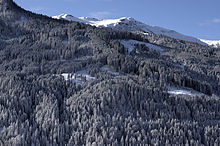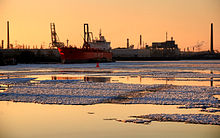 Winter
Winter
Winter is the coldest season of the year in temperate climates, between autumn and spring. It is caused by the axis of the Earth in the respective hemisphere being oriented away from the Sun. Different cultures define different dates as the start of winter, and some use a definition based on weather, but when it is winter in the Northern Hemisphere it is summer in the Southern Hemisphere, and vice versa. In many regions, winter is associated with snow and freezing temperatures. At the winter solstice, the days are shortest and the nights are longest, with days lengthening as the season progresses after the solstice.
The tilt of the Earth’s axis relative to its orbital plane plays a big role in the weather. The Earth is tilted at an angle of 23.44° to the plane of its orbit, and this causes different latitudes on the Earth to directly face the Sun as the Earth moves through its orbit. It is this variation that primarily brings about the seasons. When it is winter in the Northern Hemisphere, the Southern Hemisphere faces the Sun more directly and thus experiences warmer temperatures than the Northern Hemisphere. Conversely, winter in the Southern Hemisphere occurs when the Northern hemisphere is tilted more toward the Sun. From the perspective of an observer on the Earth, the winter Sun has a lower maximum altitude in the sky than the summer Sun.
During winter in either hemisphere, the lower altitude of the Sun causes the sunlight to hit that hemisphere at an oblique angle. In regions experiencing winter, the same amount of solar radiation is spread out over a larger area. This effect is compounded by the larger distance that the light must travel through the atmosphere, allowing the atmosphere to dissipate more heat. Compared with these effects, the changes in the distance of the earth from the sun are negligible.
In the Northern Hemisphere, some authorities define the period of winter based on astronomical fixed points (i.e. based solely on the position of the Earth in its orbit around the sun), regardless of weather conditions. In one version of this definition, winter begins at the winter solstice and ends at the vernal equinox. These dates are somewhat later than those used to define the beginning and end of the meteorological winter – usually considered to span the entirety of December, January, and February in the Northern Hemisphere and June, July, and August in the Southern.
Astronomically, the winter solstice,being the day of the year which has fewest hours of daylight, ought to be the middle of the season, but seasonal lag means that the coldest period normally follows the solstice by a few weeks. In the USA and Canada (and sometimes in Britain) the season is regarded as beginning at the solstice and ending on the following equinox – in the Northern Hemisphere, depending on the year, this corresponds to the period between 21 or 22 December and 19, 20 or 21 March. In the UK, meteorologists consider winter to be the three coldest months of December, January and February. In Scandinavia, winter traditionally begins on 14 October and ends on the last day of February. In many countries in the Southern Hemisphere, including Australia, New Zealand and South Africa, winter begins on 1 June and ends on 31 August. In Celtic nations such as Ireland (using the Irish calendar) and in Scandinavia, the winter solstice is traditionally considered as midwinter, with the winter season beginning 1 November, on All Hallows, or Samhain. Winter ends and spring begins on Imbolc, or Candlemas, which is 1 or 2 February . This system of seasons is based on the length of days exclusively. (The three-month period of the shortest days and weakest solar radiation occurs during November, December, and January in the Northern Hemisphere and May through July in the Southern Hemisphere.)
Also, many mainland European countries tend to recognize Martinmas or St Martin’s Day (11 November), as the first calendar day of winter. The day falls at midpoint between the old Julian equinox and solstice dates. Also, Valentine’s Day (14 February) is recognized by some countries as heralding the first rites of spring, such as flowers blooming.
In Chinese astronomy and other East Asian calendars, winter is taken to commence on or around 7 November, with the Jieqi (known as 立冬 lì dōng—literally, “establishment of winter”).
The three-month period associated with the coldest average temperatures typically begins somewhere in late November or early December in the Northern Hemisphere and lasts through late February or early March. This “thermological winter” is earlier than the solstice delimited definition, but later than the daylight (Celtic) definition. Depending on seasonal lag, this period will vary between climatic regions.
Cultural influences such as Christmas creep may have led to the winter season being perceived as beginning earlier in recent years, although high latitude countries like Canada are usually well into their real winters before the December solstice.
Ecological reckoning of winter differs from calendar-based methods by avoiding the use of fixed dates. It is one of six seasons recognized by most ecologists who customarily use the term hibernal for this period of the year (the other ecological seasons being prevernal, vernal, estival, serotinal, and autumnal). The hibernal season coincides with the main period of biolological dormancy each year whose dates vary according to local and regional climates in temperate zones of the Earth. The appearance of flowering plants like the crocus can mark the end of the ecological winter as early as late January in mild temperate climates.
To survive the harshness of winter, many animals have developed different behavioral and morphological adaptations for overwintering:
- Migration is a common effect of winter upon animals, notably birds. However, the majority of birds do not migrate—the cardinal and European Robin, for example. Some butterflies also migrate seasonally.
- Hibernation is a state of reduced Metabolic activity during the winter. Some animals “sleep” during winter and only come out when the warm weather returns; e.g., gophers, frogs, snakes, and bats.
- Some animals store food for the winter and live on it instead of hibernating completely. This is the case for squirrels, beavers, skunks, badgers and raccoons.
- Resistance is observed when an animal endures winter but changes in ways such as color and musculature. The color of the fur or plumage changes to white (in order to be confused with snow) and thus retains its cryptic coloration year-round. Examples are the Rock Ptarmigan, arctic fox, weasel, white-tailed jakrabbit, and mountain hare.
- Some fur-coated mammals grow a heavier coat during the winter; this improves the heat-retention qualities of the fur. The coat is then shed following the winter season to allow better cooling. The heavier coat in winter made it a favorite season for trappers, who sought more profitable skins.
- Snow also affects the ways animals behave; many take advantage of the insulating properties of snow by burrowing in it. Mice and voles typically live under the snow layer.
Some annual plants never survive the winter. Other annual plants require winter cold to complete their life cycle, this is known as vernalization. As for perennials, many small ones profit from the insulating effects of snow by being ried in it. Larger plants, particularly deciduous trees, usually let their upper part go dormant, but their roots are still protected by the snow layer. Few plants bloom in the winter, one exception being the flowering plum, which flowers in time for Chinese New Year. The process by which plants become acclimated to cold weather is called hardening.














